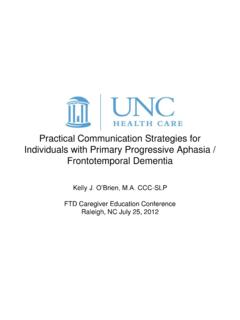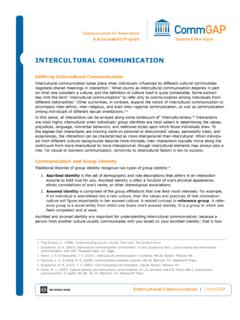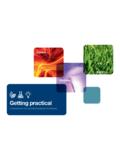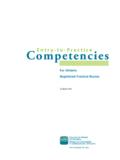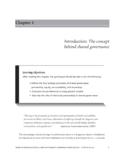Transcription of 10 Practical Tips for Classroom Aids of Autistic …
1 10 Practical tips for ClassroomAids of Autistic ChildrenTen Simple less. Require the child to look at you for more information. When you do speak, insertlots of pauses for the child to react. Remember, even Autistic children with good speech stillhave a communications to make your speech similar to that of speech to a typical child. This means fewercommands and more commentary. There is the potty room instead of Go potty . Or Bears are brown instead of use the brown crayon . walking to places, make your travel as typical as possible. Avoid hand holding,instead use tricks like speeding up, slowing down, unexpected stops or turns, to teach thechild to regulate to you. If you need to hold hands, use the hand holding as a means to closethe zone of connection. Do not physically lead the child with your hand, rather just have it actas a connection for the child to regulate his/her distance.
2 It is best that the child hold yourhand or finger instead of you grasping trying to get the child's attention, avoid repeated use of the child's name. Othersounds, like clicking your tongue, clearing your throat, snapping fingers, etc. are processed bydifferent areas of the brain. Thus, a non-speech sound often gets the child s attention. Followup with a, there you are so-and-so to reinforce the child's the child is getting self absorbed, interrupt his activity. If drawing for example, brieflyhold his pencil hand until the child looks at you to figure out why you are holding his the child references you, try to point out something novel. A new color, do a funnyface, a child gets beyond a threshold of excitement or emotion, remove the child to a quietplace and give him/her 10 or 15 minutes to recompose.
3 Do not try to console or calm. Justleave them to themselves and supervise from a distance. For many children this is abiochemical weakness where the adrenal / cortisone system cannot properly shut down. Letthe chemistry work out then return to the activity of the lots of situations where the child needs to look at you or observe another personfor instruction. This can be as simple as you shaking your head yes or no for a snack, or ascomplicated as observing a classmate write letters. In all cases, reinforce the idea that othershave a mind and that the child can understand that mind by and praise actual accomplishment. Be tepid about mediocre effort. True feelingsof success and competence are very motivating. Autistic children are more than smart enoughto feel NOT set up social situations where the child is bound to fail.
4 For most children thiswould be social situations. Keep social interactions with peers short with specific goals inmind and be there to mediate and repair the interactions. Every attempt to play with a childthat fails is de-motivating socially for the child. Do set up social situations where success t get hung up prompting the child on greetings and partings. There are manyencounters in a school day and few Autistic children understand them or there the aid can do the greetings and partings, modeling them for the child. Create a pausefor the child to participate but do NOT train the child in a script of good-bye or hello . If thechild shows true pleasure at a meeting or discomfort or longing at a parting, then the peopleinvolved are doing a GREAT job because it means the child is developing emotional single big smile from the child when greeted is worth 1,000 monotone hellos.
5 The childwill develop natural utterances over time if the emotional response is Rational Behind the TipsAutism or Autism Spectrum Disorders (ASD) are becoming more and more understood. Newresearch and clinical practices are showing the way to have very effective communication withautistic individuals and there are real reasons for optimism with regard to this generation ofautistics. A great deal of the reason for hope deals with biomedical intervention and the newunderstandings of genetics and metabolism and how these compromised systems result in ASDsymptoms. New therapies, drugs, supplements, and diets are producing wonderful results and theknowledge base for these interventions is growing the behavioral front, there are also real reasons for optimism and very Practical strategies fordealing with ASD individuals.
6 For years, as the ASD epidemic has emerged, professionals havebeen developing plans and compensations for helping ASD children . Some of the early strategieshave proven flawed and replacements have been developed. One of the profound shifts inthinking regarding autism has been the specification of the core deficits of autism andadjustments to the compensations for the deficits. Specifically, autism is not a language disorder,it is a communications disorder. Autism is not a lack of social ability, it is a lack or loss offundamental social skills. Autism is not a lack of intelligence or imagination, it is a loss ofconnection with the motivations of the human neuro-typical , modern autism intervention deals with very fundamental social skills andcommunications skills. These are skills that are typically acquired in the first 18 months of age,long before language develops.
7 These skills focus around understanding significant individualsand reading their faces and bodies for information. They focus on using imitation for learning,sharing emotions, regulating to the actions of another. The modern models suggests and hasshown in some studies that ASD individuals readily develop a theory of mind when thesefundamental skills are taught and developed. The lack of language or delayed language appearsto be primarily a physical problem based upon imbalances in glutamates to GABA in the brainsometimes influenced by difficulties in motor planning. Thus, it is very likely in most ASDindividuals that the core social skills training can take place and the ability to communicate canbe fostered at the same time that the biological barriers to language development arecompensated for by language therapy, biomedical interventions, speech substitutes like signlanguage, picture exchange, or supplemental language , the overarching strategy is to support or compensate for physical or biomedical issuesin the ASD child, while, at the same time, going back to very early developmental skills trainingto fill in the skills necessary for successful communication and social development.
8 The trick isto separate and recognize missing skills from biomedical problems. This is where professionalscan supply a great deal of insight. For example, is hyperactivity a metabolic problem, or is it abehavioral problem, or both. Can a behavioral tactic be applied even in a situation where ametabolic problem list of suggestions above are designed to keep the relationship between the school aid andthe ASD child as productive and positive as possible. The idea behind speaking less is that theASD child has difficulty in understanding speech or the meanings behind speech. Furthermore,sound is omni-directional. Sight, on the other hand is directional and requires the child to payattention to the transmitting individual. When we speak less, we encourage the ASD child tolook for other ways to gain understanding, much like an 18 month or less child would have to encourages the development of fundamental skills.
9 Even when speech is involved, we wantthoughtful interpretation of speech. Verbal ASD children often fail to be conversational. Theyrequest and respond but to not communicate in a typical way. Thus, slower, deliberate languagethat departs from scripted speech, exercises and encourages thoughtful language. Many ASDchildren also have language processing delays that are likely neurological or biologicallyinduced. Thus, slowing speech and providing processing pauses creates success for the ASDchild. For an individual with slower language processing, every utterance to them restarts theprocessing clock. So, as unnatural as it may feel, when talking to an ASD child with slowlanguage processing we must avoid rephrasing, or re-asking questions until the child has had the5 seconds or so that they need to process the first ASD children with severe speech difficulty, it is best to concentrate on nonverbalcommunication to keep the relationship healthy.
10 Touch, pointing, facial referencing, bodyposture, imitation, and simple verbal interactions are all ways of minimizing speech and yetencouraging communication. There is a great deal of communication and learning that can takeplace in the absence of speech. In fact, many autistics learn to read and write prior to theemergence of language. The Classroom aid can hasten the development of non-speech languageby finding ways of communicating that minimize the load on speech of the biggest challenges an aid to an ASD child faces is coming up with more typicalmotivations for the child. In order for a child to develop interests they must experience , the aid must teach the child significance. Furthermore, most of a young child s motivationsare based upon the reactions of significant others, like their parents.
